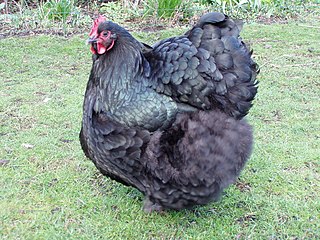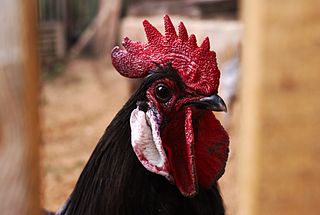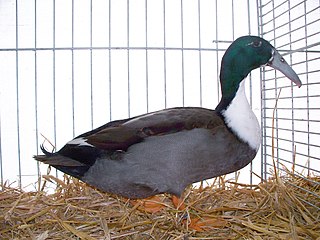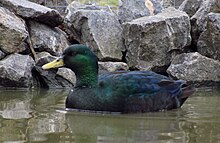
The Orpington is a British breed of chicken. It was bred in the late nineteenth century by William Cook of Orpington, Kent, in south-east England. It was intended to be a dual-purpose breed, to be reared both for eggs and for meat, but soon became exclusively a show bird.

The Dorking is a British breed of domestic chicken. It is named after the town of Dorking, in Surrey in southern England.

The Cochin is a breed of large domestic chicken. It derives from large feather-legged chickens brought from China to Europe and North America in the 1840s and 1850s. It is reared principally for exhibition. It was formerly known as Cochin-China.

The Malay is a breed of game chicken. It is among the tallest breeds of chicken, and may stand over 90 cm high. The Malay is bred principally in Europe, and in Australia and the United States. It was derived, partly in Devon and Cornwall in south-west England, from birds imported from Indian subcontinent or South-east Asia in the first decades of the nineteenth century, when large birds of this type were widespread in northern India, in Indonesia and in the Malay Peninsula.

Indian Runners are a breed of Anas platyrhynchos domesticus, the domestic duck. They stand erect like penguins and, rather than waddling, they run. The females usually lay about 300 to 350 eggs a year or more, depending whether they are from exhibition or utility strains. They were found on the Indonesian islands of Lombok, Java and Bali where they were 'walked' to market and sold as egg-layers or for meat. These ducks do not fly and only rarely form nests and incubate their own eggs. They run or walk, often dropping their eggs wherever they happen to be. Duck-breeders need to house their birds overnight or be vigilant in picking up the eggs to prevent them from being taken by other animals.

The Japanese Bantam or Chabo is a Japanese breed of ornamental chicken. It is a true bantam breed, meaning that it has no large fowl counterpart. It characterised by very short legs and a large upright tail that reaches much higher than the head of the bird.

The Campbell is a British breed of domestic duck. It was developed at Uley, in Gloucestershire, England, at the turn of the 20th century; being introduced to the public in 1898 and the Khaki variety in 1901.

The Blue Andalusian, Spanish: Andaluza Azul, is a breed of domestic chicken indigenous to the autonomous community of Andalusia in south-west Spain. It is distributed through much of the countryside of Córdoba and Seville, and is concentrated particularly in the area of Utrera, which is considered the heartland of the breed. In 2009 the population was estimated at 10000 birds.

The Rouen is a heavyweight breed of domesticated duck. Rouens are raised primarily for meat, exhibition, or as general purpose ducks. Since they are not prolific egg layers, Rouen ducks are most commonly bred for their meat. The breed originated in France sometime before the 19th century.

The Call is a historic breed of small domestic duck. It is believed to have originated in the Netherlands, where the earliest descriptions and depictions of it date from the seventeenth century. It is similar in appearance to some other breeds of duck, but is much smaller, with a round head and very short bill. Ducks, but not drakes, are very loquacious and noisy, with a piercing high-pitched call which be heard from far away.

The Orpington or Buff Orpington Duck is a breed of domestic duck. It is a dual-purpose breed used for meat and egg production. It is capable of laying up to 220 eggs a year. Originally created by William Cook of Orpington, Kent, UK, from the selection of mis-marked Blue Orpington Ducks; Cook was also the developer of the Orpington chicken. The breeds used in the development of the breed included Cayuga, Indian Runner, commercial Aylesbury and Rouen. It is proposed that Cook's intentions for the breed were to capitalize on the growing demand for the buff colour pattern. The Buff Orpington Duck was introduced to the public at the Dairy Show, the Agricultural Hall (q.v.), Islington, London in October 1897. It is considered a threatened breed by the ALBC. This breed was admitted to the British Poultry Standard in 1910 and the American Poultry Associations Standard of Perfection as the 'Buff Duck' in the Medium class in 1914. The Orpington duck is available in three colour varieties: Buff, Blond and Brown. The Buff Orpington is an unstable colour due to a blue dilution gene which means that from the offspring, all three colour variations will appear.

The Sebastopol is a breed of domestic goose, descended from the European Greylag goose. First exhibited in England in 1860 under the name 'Sebastopol goose'; they were also referred to as Danubian geese; a name first used for the breed in Ireland in 1863. 'Danubian' was used as a synonym in the 19th century; and only given precedence by Edward Brown after the turn of the 19th century. The Sebastopol is a medium-sized goose with long, white curly feathers. The feathers of the neck are smooth and sometimes greyish brown. Crosses have produced all-grey, buff, and saddle back variants. Feathers on the breast may be curly (frizzle) or smooth. The gander weighs 12-14 lbs while the goose weighs 10-12 lbs. The legs and shanks are orange and the eyes bright blue. Grey and buff colored Sebastopol have brown eyes. On average, females produce 25-35 eggs per year. Though domesticated breeds of geese generally retain some flight ability, Sebastopols cannot fly well due to the curliness of their feathers and have difficulty getting off the ground. They need plenty of water to keep themselves clean, and to clean their sinuses.

The Magpie is a British breed of domestic duck. It has distinctive black and white markings reminiscent of the European magpie, and is a good layer of large eggs.

The Minorca, Catalan: Gallina de Menorca, Spanish: Menorquina, is a breed of domestic chicken originating in the Mediterranean island of Menorca, in the Balearic Islands to the south-east of Spain. It is a well-known exhibition bird in many countries of the world, but in the island of Menorca is an endangered breed and considered to be at risk of extinction.

The Sebright is a British breed of bantam chicken. It is a true bantam – a miniature bird with no corresponding large version – and is one of the oldest recorded British bantam breeds. It is named after Sir John Saunders Sebright, who created it as an ornamental breed by selective breeding in the early nineteenth century.

The Modern Game is a breed of ornamental chicken which originated in England between 1850 and 1900. Purely an exhibition bird, Modern Game were developed to be most aesthetically pleasing and to epitomize the visual appeal of the gamecock or fighting cock.

The Booted Bantam or Dutch Booted Bantam is a European breed of true bantam chicken. It is characterised by abundant feathering on the feet and shanks, which gives it a "booted" appearance; and by vulture hocks, long stiff downward-pointing feathers on backs of the thighs, from which the Dutch name Sabelpoot ("sabre-legged") derives.

The Silver Appleyard is a British breed of domestic duck. It was bred in the first half of the twentieth century by Reginald Appleyard, with the aim of creating a dual-purpose breed that would provide both a good quantity of meat and plenty of eggs.

The Hook Bill or Dutch Hookbill is a breed of domestic duck characterised by an unusual down-curved beak. It is an ancient breed, and has been documented since the seventeenth century. Speculation that it originated in Asia, or is related to the Indian Runner, is apparently unsubstantiated.

The British Poultry Standard is the oldest poultry fancy breed standard in the world. It is published by the Poultry Club of Great Britain and is the official reference standard used by judges at poultry shows within the United Kingdom and the Republic of Ireland.





















